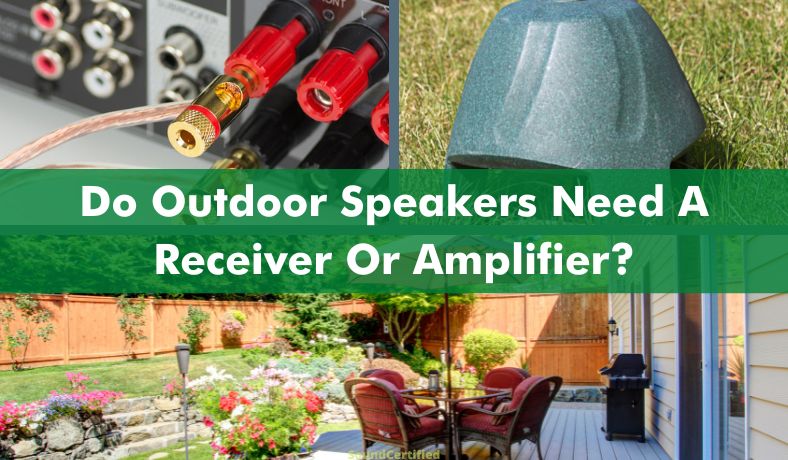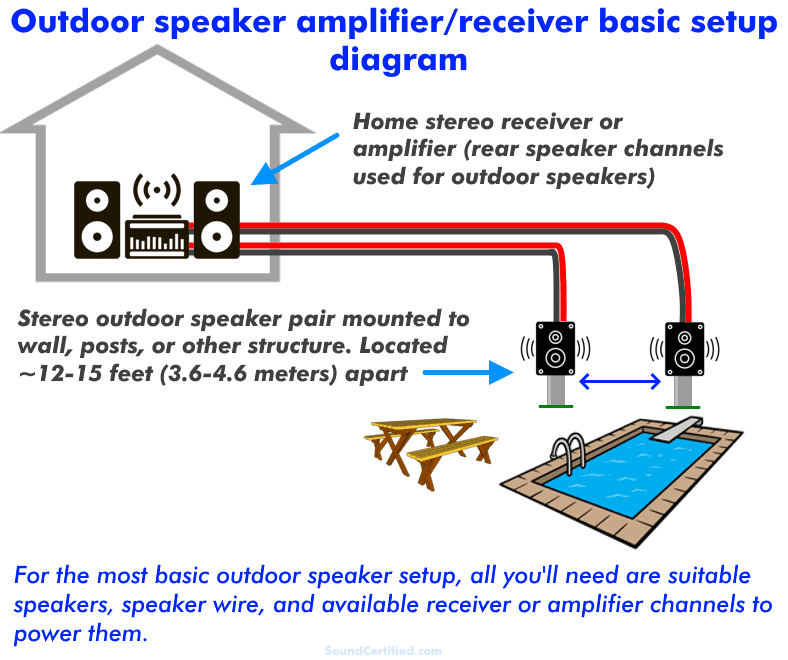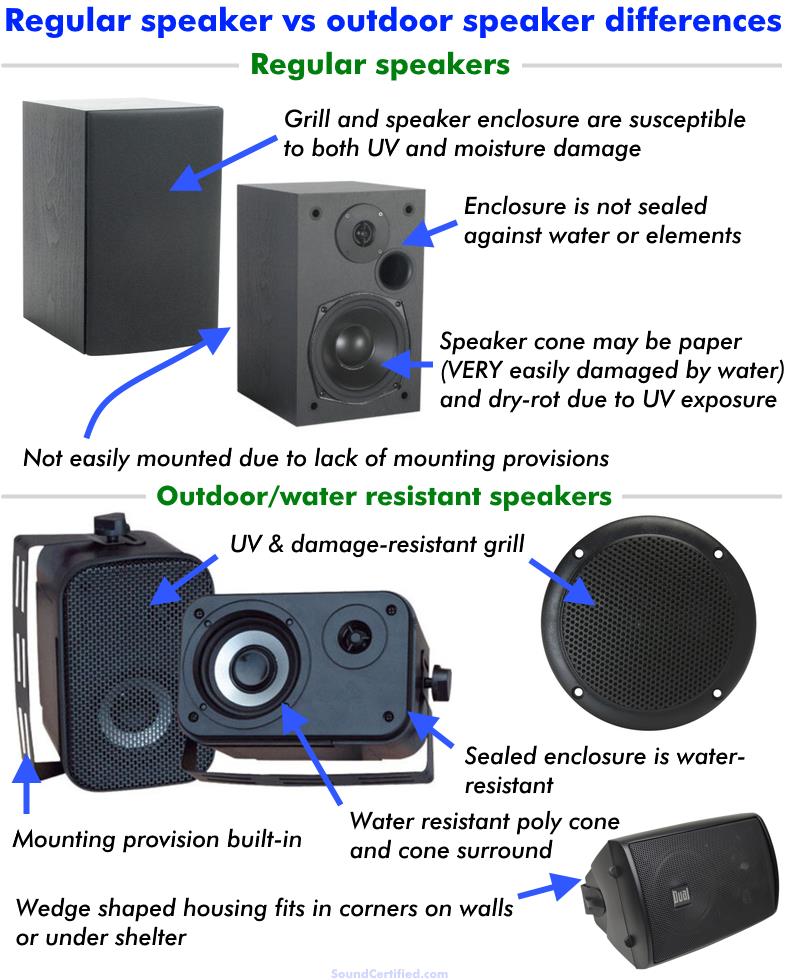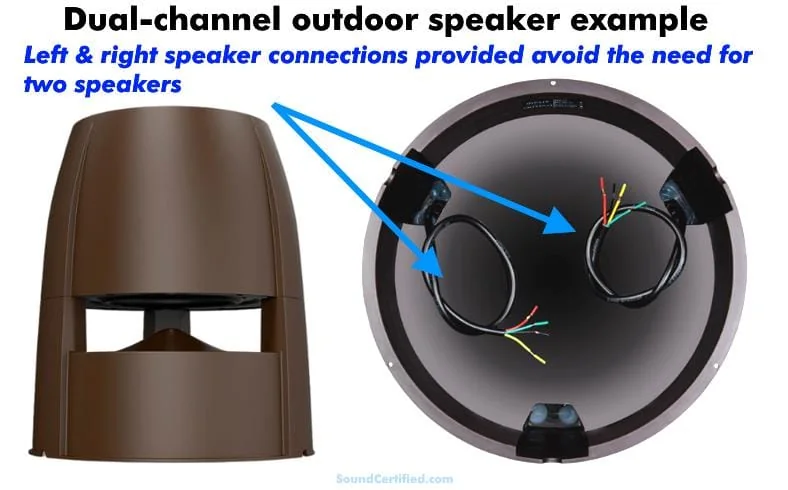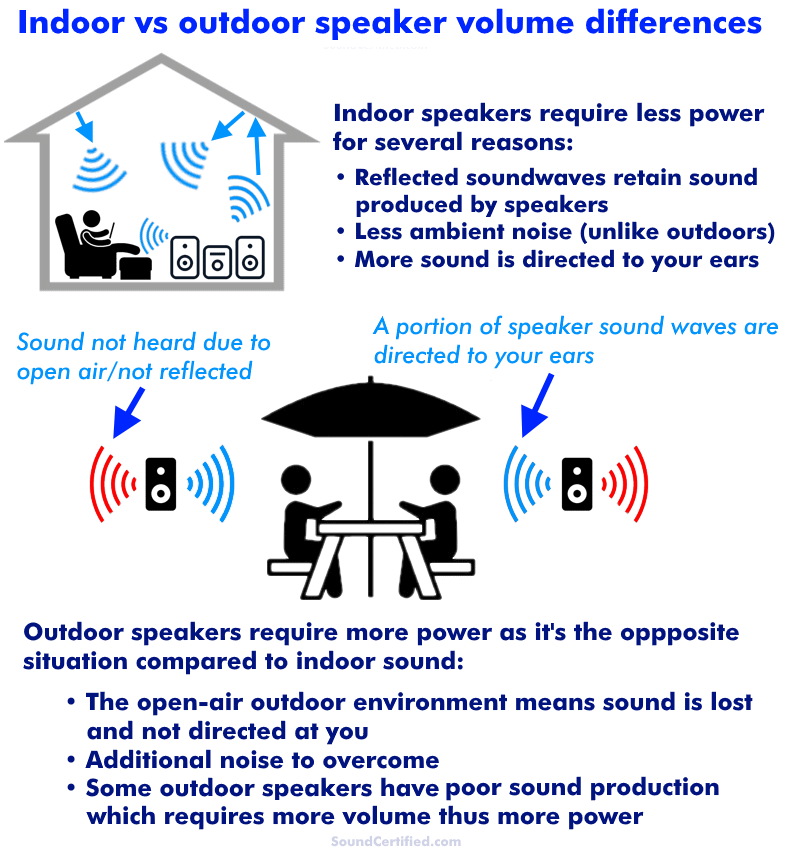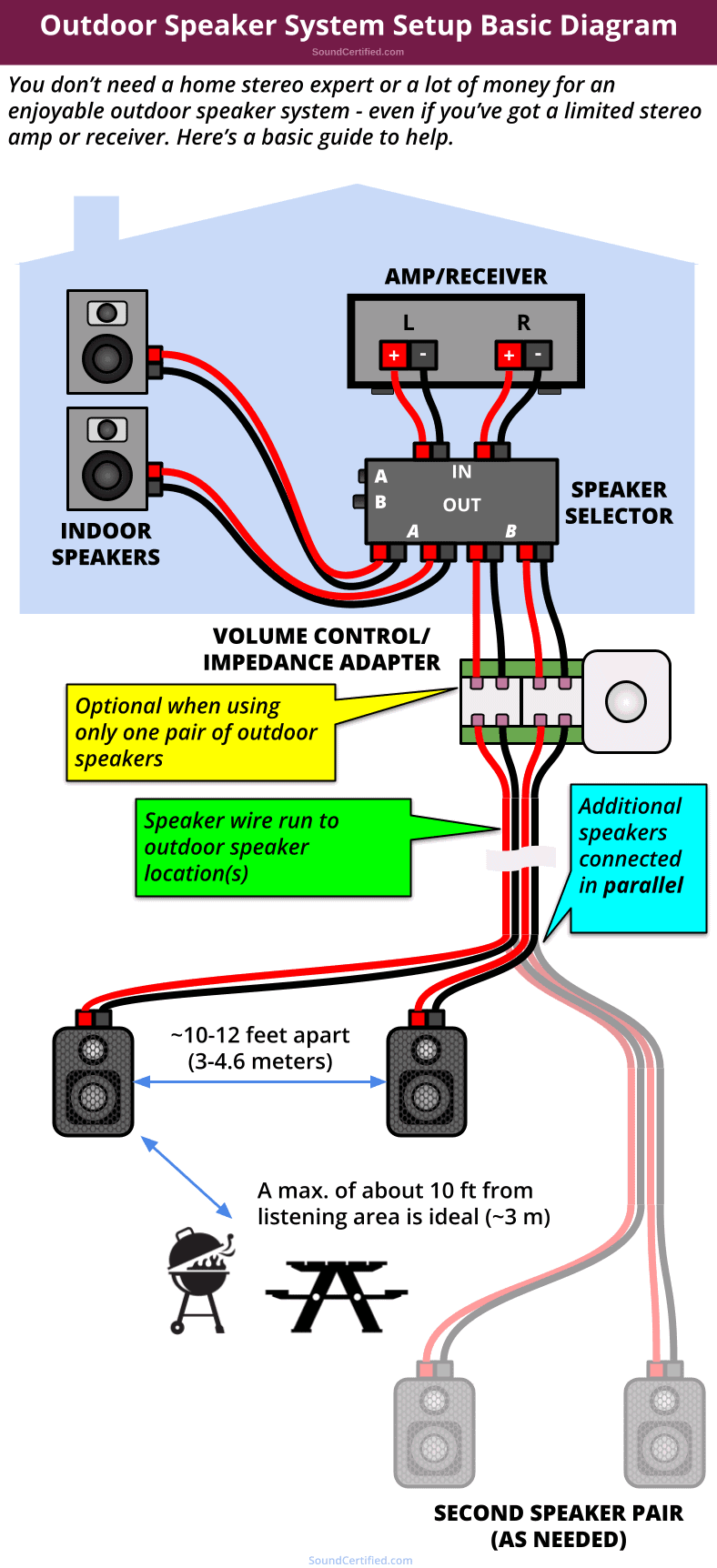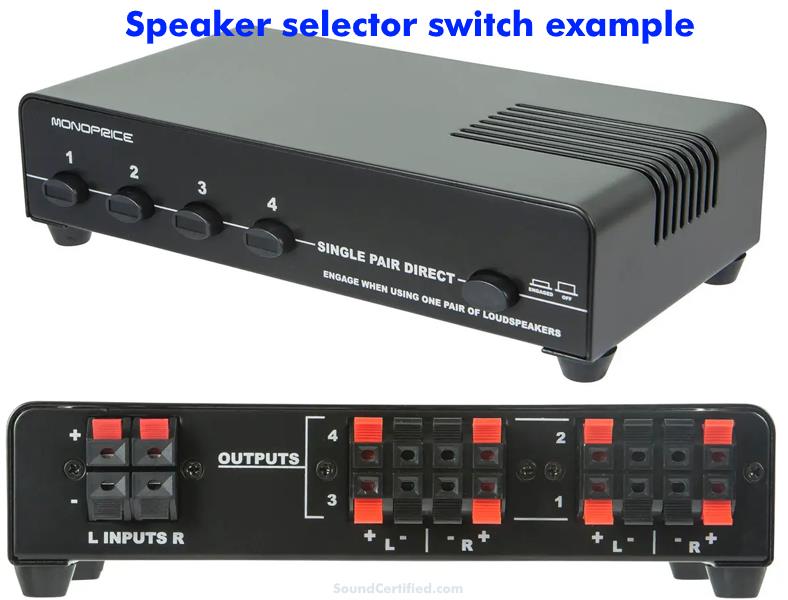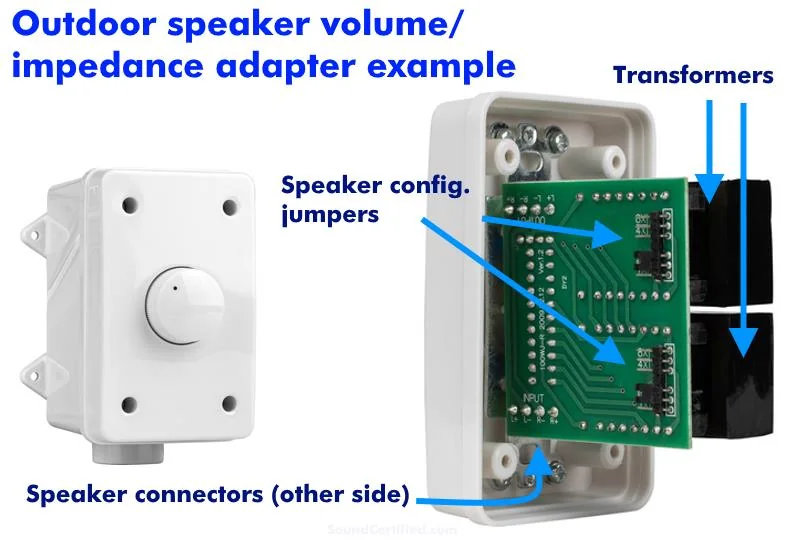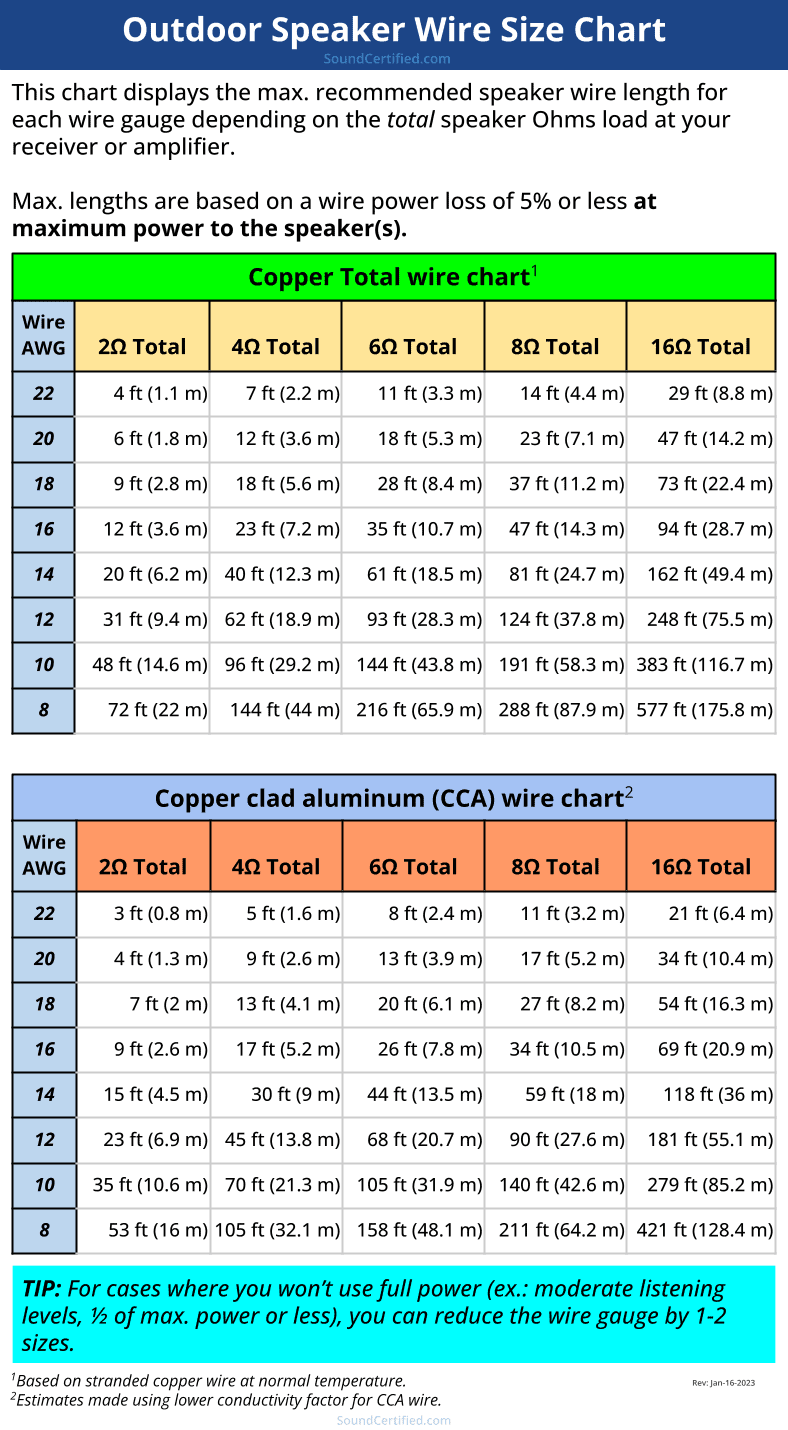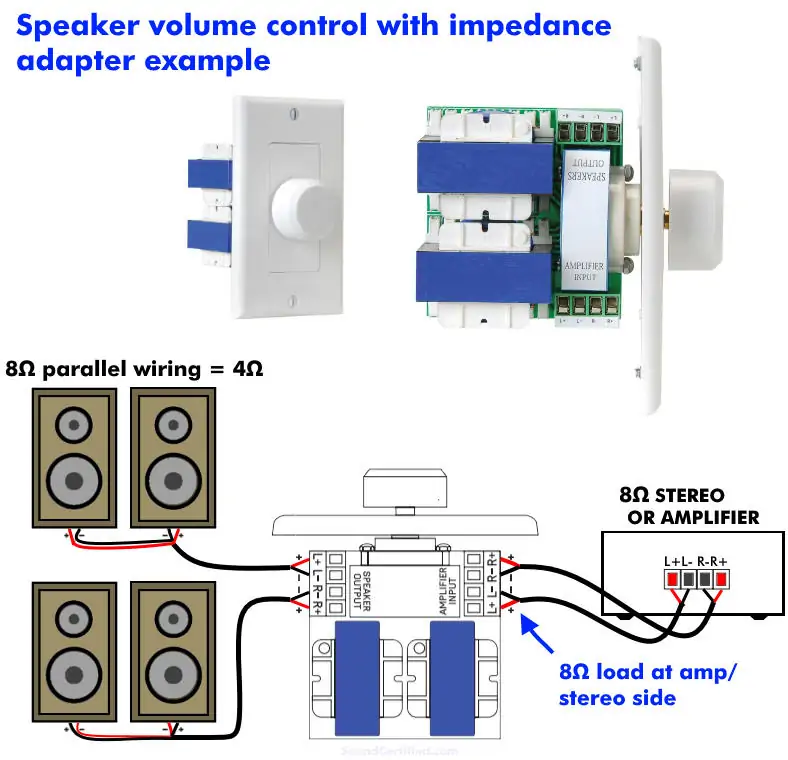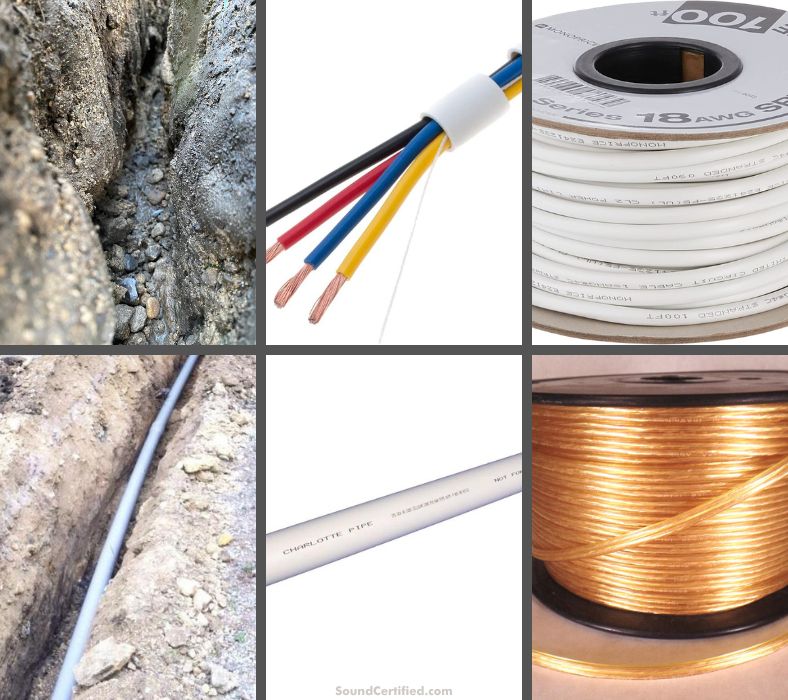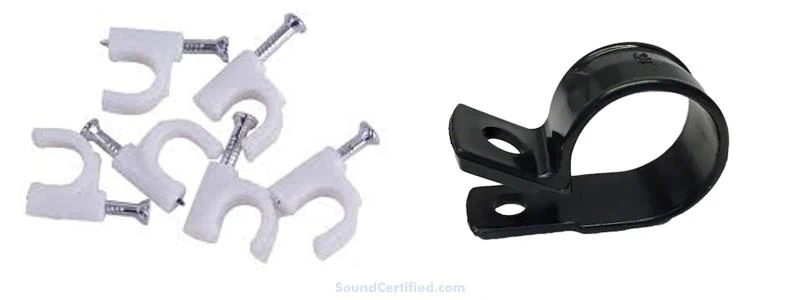In this article, I share the basics to know about outdoor speakers:
- How to power them
- Regular vs outdoor speaker differences
- Your different options for enjoying your tunes outside
- Some great DIY tips for installing and setting up an outdoor speaker system
Contents
Do outdoor speakers need a receiver or amplifier?
Yes, standard non-powered outdoor speakers will require a receiver, amplifier, or stereo with amplified speaker outputs to power them. You’ll also need a music source.
On the other hand, Bluetooth and other powered speakers don’t require a receiver or amp as they already contain one. Powered speakers are also called active and non-powered ones passive.
Can you put regular speakers outside?
Generally speaking, no, you should not use regular speakers outside. Standard home stereo speakers are vulnerable to damage from common everyday outdoor elements such as:
- Heat
- Sunshine UV (ultraviolet light)
- Moisture: rain, humidity
- Pests or animals
- Dirt, dust, and other contaminants
- Outdoor temperatures
In situations where the speakers are sheltered from rain and aren’t often exposed to the elements I’ve listed here (like those mounted under a roof or to covered walls in moderate climates), it can work out fine.
As a general rule, however, you’re better off buying outdoor speakers unless you don’t mind removing regular stereo speakers and taking them back indoors when not in use. Regular speakers simply don’t hold up over time when used outside in most cases.
Regular speakers vs outdoor speaker differences
Regular speakers often have the following things in common:
- Paper cones or paper bobbins (the tube structure the voice coil is built on)
- Speaker enclosure material that’s very sensitive to water and moisture: wood, pressed particle board, or medium-density fiberboard (MDF)
- Not water tight and not sealed, which means moisture and other things can get inside and cause oxidation or even corrosion
- Soft speaker grills which can tear easily or allow damage to the speakers
- Lack of mounting provisions
- Poor speaker wire connection points, such as poor spring clip terminals
Outdoor speakers have the following:
- Treated type cones or poly/plastic cones and bobbins which are resistant to outdoor elements and moisture
- Plastic or other water-resistant speaker box materials are used
- Many are sealed or designed to help keep out water, moisture, and pests
- Designed with solid speaker grills and in such a way the speaker cones cannot be damaged
- Mounting bracket support or other mounting options are provided
- Secure speaker wire connection points that are better suited for a reliable connection, especially outdoors
Outdoor speaker products are similar to marine and boat speakers in that they’re weather-resistant and don’t use a wood or particle board speaker enclosure that can warp easily when wet. Harsher temperatures are less likely to harm them also.
Models with both left and right amplifier speaker connections make setup easier as they remove the problem caused by the need to place speakers close to each other for stereo sound. Music content from both stereo channels can be heard even if only one speaker is used.
You can also buy outdoor speakers that blend into the scenery such as false rock or decorative designs like light fixtures.
How much power do outdoor speakers need?
- A good rule of thumb is a minimum of 50 watts RMS/continuous power per channel for good quality speakers placed relatively close to you (within 10-15 feet/3-4.5 meters). Note that this is for one speaker pair.
- For less efficient speakers, single cone speaker models, and those placed further away, 75W to 100W per pair is recommended. Good speakers feature a tweeter which helps with clarity and volume you can hear.
- Double the recommended power for additional speaker pairs wired to the same amplifier, AV receiver, or home theater receiver channels. This is because speakers connected to the same speaker output channel share the available power.
- Pool parties, birthday parties, and other noisy environments can require more power to get the speaker volume you need. If you’ll be hosting parties, it’s best to plan ahead and have plenty of power available. Consider getting an amp with at least 80W-100W per channel.
- If you enjoy casual, moderate volume listening in a fairly calm and quiet listening environment, you can get by with 50W/channel and even less. For example, for quiet outdoor listening on your patio, deck, or other small areas, as little as 15W to 25W can work fine for full-range speakers (no subwoofers).
- If you’re after bass and using subwoofers outdoors, I would recommend at least 100 to 150 watts per subwoofer. Woofer/subwoofer systems are power-hungry and can require a ton of power – mainly due to the lost sound waves, unlike in an indoor environment.
Outdoor speakers can require a lot higher wattage to be supplied to them to be heard at the same level as indoor speakers. That’s because indoor speaker systems have sound waves reflected off nearby walls in a room unlike outdoor speakers in an open air environment. The sound quality you hear can be very different as well.
This means that, unlike outdoor speakers, when indoors you can hear them much more easily and less power is needed. Likewise, the lack of nearby sound reflections outdoors means the minimum power required for a good listening experience will be higher.
Realistically speaking, you can get by with less power if you must, but you’ll need to compensate for that by having the speakers closer to you than you could otherwise. A good example is average listening to a pair out on your patio.
If you’re a fan of streaming audio via your smartphone but don’t think you’re getting the volume you should, equalizer and audio booster apps can help. They allow you to increase the signal level or boost some audio frequency bands to hear it more easily.
They’re also already built into some smartphone sound setting options and popular music player apps.
What do you need to hook up outdoor speakers? (BASIC DIAGRAM)
For a basic outdoor speaker system with standard non-powered speakers, you’ll need the following at a minimum:
- An amplifier, AV receiver, or home theater receiver to power the speakers. These should not be used outside where they’re susceptible to weather, temperatures, and moisture.
- Speaker wire of the correct wire gauge and length.
- Speaker wire connectors (as needed).
- Mounting accessories: mounting brackets, sheet metal or self-tapping screws. Drywall screws can also work very well.
- For connections or wire exposed to the elements, anti-corrosion spray or similar protectant gel.
For multi-speaker outdoor setups or if you’d prefer to have selectable speaker zone control, the following is needed:
- A multi-zone capable receiver or amplifier OR selectable speaker switch/speaker impedance adapter.
- Additional speaker wire, as needed.
A basic speaker selector box cost starts at around $20 USD, so they’re a great investment.
Speaker volume controls with built-in speaker impedance adapters are affordable as well (around $26 for one rated 100W/channel) and can be mounted to a nearby wall or even flush mounted if you like, much like a standard wall light switch.
Outdoor speaker wire size
I cover speaker wire gauge in more detail in my post about the right size speaker wire. However, here’s a quick reference chart based not just on the length but also on amp power related to speaker Ohms.
Essentially, you’ll need to know 1) the total speaker load to be used at your amp or receiver and 2) the approximate length of wire you’ll need.
If you aren’t driving your speakers at full power (for example moderate listening levels of no more than 1/2 of the power available) to all speakers, you can reduce the wire gauge needed by a size if you like.
Can you use multiple outdoor speakers on an amp or stereo?
Yes, it is possible to use two or more pairs of speakers on an amplifier or home receiver. The most efficient way is by using a speaker impedance adapter. For example, you can use multiple 8 ohm outdoor speakers on one 8 ohm minimum stereo amplifier or receiver.
What does a speaker impedance adapter do?
A speaker impedance adapter, like the one pictured above built into a stereo speaker volume control, allows you to wire extra speakers in parallel for the best sound quality and power while maintaining a safe total Ohms load. Amplifiers or receivers will see the correct total speaker impedance (Ohms load) speaker terminal side.
This is made possible by the use of small step-up/step-down transformers which can scale the amplified speaker voltage much like a power adapter in your home to change the output applied to the speakers. This effectively maintains the same power available to the speakers but the speaker output limits aren’t presented with too low of an Ohms load.
For example, ordinarily you cannot wire an 8 ohm stereo speaker pair to a single 8 ohm rated amplifier channel as it would result in a total of 4 ohms. However, we can use a speaker impedance adapter to maintain an 8 ohm load on the amp’s speaker output side. Each speaker will receive 1/2 of the channel power as they normally would.
Many feature a volume control as well, which means you can adjust your lawn, patio, or pool speaker volume easily too once everything is set up.
What if I only have 2 speaker channels or don’t have enough unused speaker outputs available?
If your existing speaker channels are already used, you don’t have a multi-zone amp or AV receiver, or don’t want to have to disconnect and reconnect existing speakers. The good news is there are options:
- A speaker control switch makes it possible to leave existing speakers connected and play your backyard speakers instead when you need them.
- A speaker impedance adapter, as I mentioned above, will allow you to have multiple speaker pairs connected without harming your stereo equipment.
A speaker selector simply changes which speakers receive power and sound, although some offer additional features.
You can use both a speaker selector and impedance adapter to get a better outdoor speaker system than would be possible otherwise: you can have extra speakers connected outdoors that only play when needed, leaving your indoor speakers untouched until you select them again.
Routing speaker wire outdoors
You’ll want to run either multi-conductor speaker cable to bury or as an alternative option, a great idea is to use 3/8″ or 1/2″ inside diameter (ID) PVC pipe as a do it yourself (DIY) option. The second option allows you to use any speaker wire you like.
Speaker cable vs standard speaker wire
Unfortunately, standard outdoor wiring is subject to being damaged outdoors as well as by moisture, pests, and a range of other potential problems. Mult-conductor speaker cable can be buried directly and is resistant to physical damage and outdoor conditions unlike standard speaker wire.
Burying your outdoor speaker wire is ideal to keep it out of the way and safe, but as a precaution, I recommend keeping it securely away from feet, pets, lawnmowers, and more.
However, it is possible to use standard speaker wire instead of having to buy and install speaker cable:
- Making a DIY wire conduit with PVC pipe from your local hardware is an easy and cheap way to do so.
- You can also run speaker wire overhead from your house underneath a roof, posts, and supports or along a fence.
Wire and cable clamps like those shown here come in really handy for suspending a long speaker wire installation and they’re cheap, too!
